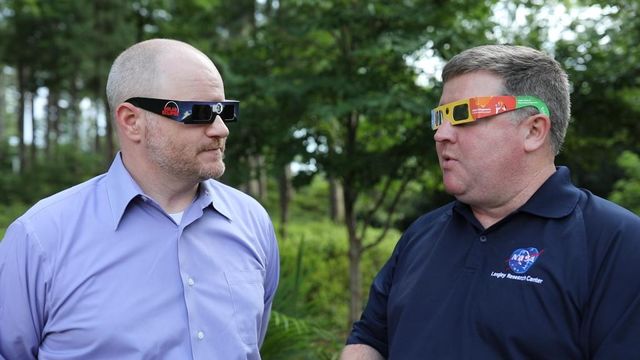NC prepares for solar eclipse to cut across western part of state
Five weeks from now, an estimated 500 million people will experience a solar eclipse.
Posted — UpdatedFive weeks from now, an estimated 500 million people will experience a solar eclipse. Those in a 70-mile wide path of totality stretching from Oregon to the Carolinas can see one of nature’s most awe-inspiring sights, a total solar eclipse. Excitement has been building for years, and hotels along the path have been sold out for nearly as long.
A total solar eclipse occurs when the moon completely covers the sun, casting a moving shadow along a path on the Earth’s surface. As the moon hides the sun’s glare, those inside that path of totality will be able to see the sun’s atmosphere or corona.
Portions of Graham, Cherokee, Clay and Macon counties in North Carolina and 32 of South Carolina’s 46 counties will experience a total solar eclipse on Aug. 21.
Amy Sayle, of the Morehead Planetarium in Chapel Hill, said it will be a sudden change packed into about two-and-a-half minutes.
"A total solar eclipse any place on earth doesn't happen that often, and to see it go dark in the daytime, how amazing is that? Bright stars, planets come out, the temperature drops, animals act like night has come, people might scream," she said. "We'll find out what happens."
A partial solar eclipse occurs when the moon partially covers the sun. These happen much more often. During a total solar eclipse, those outside of the path of totality experience a partial solar eclipse. Visible anywhere the sun is above the horizon. The rest of the U.S., Canada, Mexico plus parts of Central America, and South America outside the path of totality will experience a partial solar eclipse.
An annular solar eclipse occurs when the moon covers the Sun’s center but leaves an annulus or “ring of fire”. This occurs near lunar apogee when the moon is at its furthest from Earth and therefore appears smaller.
The next annular solar eclipse visible from the United States isn’t until 2023 and we won't see one from North Carolina until March 26, 2267.
A lunar eclipse occurs when the moon passes through the shadow cast by the Earth. Like a partial solar eclipse, these are visible anywhere the moon is above the horizon.
The next partial lunar eclipse will be January 31, 2018, and the next total lunar eclipse will be Jan 20, 2019.
If you'd like to be in the path of totality, your opportunities are fading fast. As of this writing, all the hotels we checked near the path of totality along I-95 in South Carolina were fully booked as well as those around Columbia. There was some availability closer to Greenville, SC. There were also a few rooms left in extreme western North Carolina.
Home and room rental services like Airbnb have some availability but at premium prices. Rentals in Charleston around the eclipse are going for $500-$1500 per night around the eclipse.
Even if you'll be experiencing the eclipse from home, don't put off making arrangements to do it safely.
Only those in the path of totality can safely look directly at the sun, and only during the 2.5 minutes of totality. Here in Central and Eastern North Carolina, we need eclipse glasses or some other method to prevent eye injury.
Eclipse glasses can be purchased online for $1-$2 or less depending on how many you buy. Look for ISO 12312-2 certification before you buy and put the glasses somewhere safe until the big day.
Locally, REI stores are selling certified glasses in a 4-pack which includes a booklet on the eclipse but stocks are very limited so call ahead. The Morehead Planetarium gift shop in Chapel Hill also has “plenty” of certified glasses available for $2 each as of this writing.
In the coming weeks, we will also have other safe viewing methods including some DIY projects you can do with your family.
- The Aug. 21, 2017, eclipse begins in Raleigh at 1:16 p.m. and ends at 4:06 p.m., about a minute earlier as you move west (1:15 p.m.-4:05 p.m. in Hillsborough), and a minute or two later as you move east (1:18 p.m.-4:07 p.m. in Rocky Mount and Goldsboro)
- "Basically the shadow moves across the country at a thousand miles an hour," Sayle said. "It'll take about 90 minutes to work it's way across the country."
- 92.85 percent of the sun’s surface will be covered as viewed from Raleigh, less as you move northeast (Roanoke Rapids: 89.24 percent), more as you move southwest (Fayetteville 95.47 percent)
- About 250 square miles of western North Carolina lie in the path of totality, that figure rises to about 600 square miles in South Carolina and more than 1,000 in Nebraska.
- The last partial solar eclipse visible from North Carolina was already underway at sunrise on Oct. 24, 2014
- The last total solar eclipse to pass through North Carolina occurred March 7, 1970
- The next total solar eclipse to pass through North Carolina will occur on May 11, 2078
- Solar eclipses occur only during a new moon. Lunar eclipses occur only during a full moon.
- This is expected to be the most viewed and most photographed eclipse in history.
Related Topics
• Credits
Copyright 2024 by Capitol Broadcasting Company. All rights reserved. This material may not be published, broadcast, rewritten or redistributed.






